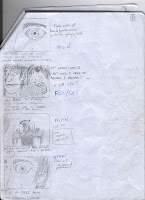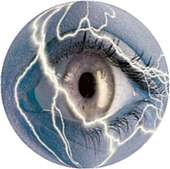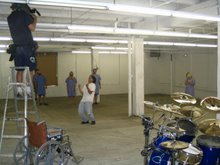Creating a storyboard is an extremely important step if you are making a film or video.
When you write out a story, you most likely envision what the scenes and shots look like....similar to actually 'watching' the video in your mind. The storyboard is nothing more than those scenes drawn out in detail, so that the director can refer to them as he/she sets up a particular scene. Think of them as comic-book representations of the images in your production. How well they are drawn out and what they look like does not matter, just as long as they convey to you and the rest of the crew reasonable idea of how the composition, framings, and cuts in your video will play out. I like to be prepared, and know exactly what look and feel that I'm going for, and storyboarding helps me do that. It also cuts the shooting time in half, saving money and lots of headaches!
Here is part of my storyboard for 'Breathe'. It is actually for the starting shots at the beginning of the video. Click on the pics to enlarge them.


As you can see, I start the shot off with a opening shot of a university. As the story progresses, so do the frames in the storyboards. Underneath each story block, I include the scene #, description of the shot, and whether it is INT/EXT and DAY/NIGHT. I also like to leave alot of space on the sides of each frame so I can include extra shot info, angles, and other notes.
Now, as you can see, I'm no artist by any means, but I try to include as much detail as I can for what the shot will tentavely look like. Even stick figures work, as long as an indepth description of the scene is there.
The amount of detail will depend on the type of scene you are creating. For a scene with 3 people sitting around a table eating, will probably be less detailed, and will serve better to help plan framing and cutting. For a crazy shot of someone running through a packed space-port out onto a moon runway will take far more detail, and will help the art dept. and visual effects crew plan and merge effects together long after the sets have been dismantled.
Now, it doesn't necessarily matter if you shoot exactly what you planned in your storyboards. It's more important what you learn while storyboarding. Until you start to plan things out on paper, you might not know how much coverage you will need for a particular scene, or if you will need specific sets pieces or props.
Whether or not you choose to draw out a storyboard, you still have to go through the 'storyboard process'. This means that you still have to plan out the visual images and details that you will use to create your project. This will range from how to frame and shoot a scene, to choosing a location, casting, sets, and props.
If you decide NOT to storyboard, you should at least create a shot list for each scene. The last thing you want to do is keep a cast and crew waiting for you to set up a shot you haven't even planned out!! You will look totally unprofessional - and it just looks bad!
When you've finally finished putting all of this together, it's on to the next step.






